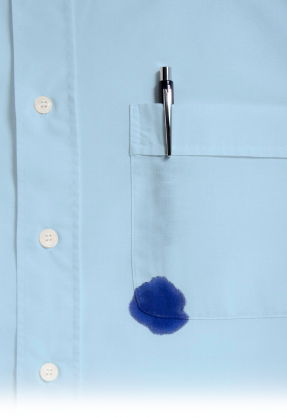
All About Stains
Successful Stain Removal
Whether it is a new or well-worn treasured garment, everyone hates to stain their clothing. We understand, and will always use our best efforts to make stains go away. Sometimes it’s pretty simple…and sometimes not. Either way, we have the professional expertise to do the job.
Successful stain removal depends largely on the nature of the stain, the type of fabric, and the colorfastness of the dye. Some fabrics and dyes simply will not withstand the use of cleaning or stain removal agents. Some stains, like ink and dried paint for example, can be impossible to remove.
“Miracle” stain removers, guaranteed to remove stains, are pretty much just that. It would be a miracle if they did the job.
Help Us Help You
Bring a stained garment to us as soon as possible to prevent the stain from setting. Stains and soil left too long on fabrics can be impossible to remove. Studies by the Dry Cleaning & Laundry Institute show that after aging for only one week, 20% of stains cannot be removed satisfactorily. After three weeks, this increases to 47%.
Show us the location of the stains, including light-colored or “invisible” spills, such as those from soft drinks, fruit juices, or white wine, and tell us any removal procedures you may have attempted before turning to us for help.
Never put a garment away for the season without it being cleaned. Every year we see garment that “weren’t dirty when I put it way for summer”, only to be taken out in the fall full of little holes and stains. The smallest unseen food crumb or spillage invites insect damage.
Don’t iron stained or soiled clothes trying to get just one more wearing out of them. Ironing dirty clothes will set stains and drive soil deeper into the fabric.
If You Must Do Something Before We Get It…
Never rub a stain. Blot the stained area. This may help remove some of the staining substance while avoiding damage to the fabric.
“But It Wasn’t Stained When I Brought It In”
Some stains caused by beverages, food or oily substances may not be visible after they dry. But later, with exposure to heat or simply the passage of time, a yellow or brownish stain will appear. This is the end result of oxidation or caramelization of sugar or sweetening agents. It is the same process that makes a peeled apple turn brown after exposure to air.
If we don’t know about it we can’t fix it, so let us know if you spilled something.
White Turns Yellow
This problem arises when white and pastel fabrics begin to yellow. When this happens, a little investigative work typically reveals a manufacturer defect in the optical or fluorescent whitening agent applied to the fabric. When this agent begins to break down as a result of exposure to light, atmospheric gases, or dry cleaning or washing solutions, yellowing results. The problem cannot be corrected and can only be prevented by the manufacturer using stable brighteners.
Consumer Related Sources of Discoloration
Perspiration – Body oils, antiperspirants, or perspiration left long enough on silk and wool garments will weaken the fabric. Frequently cleaning clothes heavily soiled with perspiration can lessen the likelihood of the problem.
Acids – Perspiration, deodorant, antiperspirant, even “all natural organic” products, fruit juice, or hair preparations can cause a change of color along with weakening of the fabric.
Alcohol – Perfume, cologne, skin freshener, aftershave, hair spray, medicine, and alcoholic beverages can cause permanent stains or color loss.
Bleach – Home bleach, hair care products, disinfectant, skin lotion, acne preparations, whitening toothpaste, medicine, cleaning products, office supplies, and other such items can cause a change or loss of color or fabric weakening depending on the dye and fabric.
Alkaline Substances – Cleaning products, toothpaste, soap, detergents, shampoo, and skin preparations can also cause problems that may not appear until the stained area has aged or the item is exposed to heat during a cleaning process.
Salt – Perspiration, beverages and food, medicine, even wintry street gutter splash or snow removal slush can result in a change in color of wool fabrics.
Hair Preparations – Permanent wave solution or other hair care products can result in a change of color. This type of staining is easily recognized by the location in the neckline, shoulder or back of garment.
Here’s What We Do
We attempt to remove stains in accordance with professional practices. However, not all stains can be removed despite our best efforts. This usually means that:
- The stains are very old, oxidized, and set in the fabric.
- The delicacy of the fabric limits the degree of removal.
- The fabric dye is soluble; that is, we would remove the dye along with the stain.
The information you provide and the sooner you give it to us, the greater the chance of satisfactory stain removal.


